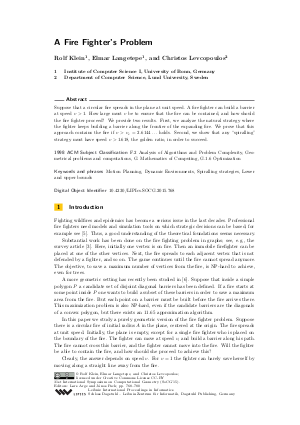A Fire Fighter’s Problem
Authors Rolf Klein, Elmar Langetepe, Christos Levcopoulos
-
Part of:
Volume:
31st International Symposium on Computational Geometry (SoCG 2015)
Part of: Series: Leibniz International Proceedings in Informatics (LIPIcs)
Part of: Conference: Symposium on Computational Geometry (SoCG) - License:
 Creative Commons Attribution 3.0 Unported license
Creative Commons Attribution 3.0 Unported license
- Publication Date: 2015-06-12
File

PDF
LIPIcs.SOCG.2015.768.pdf
- Filesize: 0.73 MB
- 13 pages
Document Identifiers
Subject Classification
Keywords
- Motion Planning
- Dynamic Environments
- Spiralling strategies
- Lower and upper bounds
Metrics
- Access Statistics
-
Total Accesses (updated on a weekly basis)
0PDF Downloads0Metadata Views
Abstract
Suppose that a circular fire spreads in the plane at unit speed. A fire fighter can build a barrier at speed v > 1. How large must v be to ensure that the fire can be contained, and how should the fire fighter proceed? We provide two results. First, we analyze the natural strategy where the fighter keeps building a barrier along the frontier of the expanding fire. We prove that this approach contains the fire if v > v_c = 2.6144... holds. Second, we show that any "spiralling" strategy must have speed v > 1.618, the golden ratio, in order to succeed.
Cite As Get BibTex
Rolf Klein, Elmar Langetepe, and Christos Levcopoulos. A Fire Fighter’s Problem. In 31st International Symposium on Computational Geometry (SoCG 2015). Leibniz International Proceedings in Informatics (LIPIcs), Volume 34, pp. 768-780, Schloss Dagstuhl – Leibniz-Zentrum für Informatik (2015)
https://doi.org/10.4230/LIPIcs.SOCG.2015.768
BibTex
@InProceedings{klein_et_al:LIPIcs.SOCG.2015.768,
author = {Klein, Rolf and Langetepe, Elmar and Levcopoulos, Christos},
title = {{A Fire Fighter’s Problem}},
booktitle = {31st International Symposium on Computational Geometry (SoCG 2015)},
pages = {768--780},
series = {Leibniz International Proceedings in Informatics (LIPIcs)},
ISBN = {978-3-939897-83-5},
ISSN = {1868-8969},
year = {2015},
volume = {34},
editor = {Arge, Lars and Pach, J\'{a}nos},
publisher = {Schloss Dagstuhl -- Leibniz-Zentrum f{\"u}r Informatik},
address = {Dagstuhl, Germany},
URL = {https://drops.dagstuhl.de/entities/document/10.4230/LIPIcs.SOCG.2015.768},
URN = {urn:nbn:de:0030-drops-51044},
doi = {10.4230/LIPIcs.SOCG.2015.768},
annote = {Keywords: Motion Planning, Dynamic Environments, Spiralling strategies, Lower and upper bounds}
}
